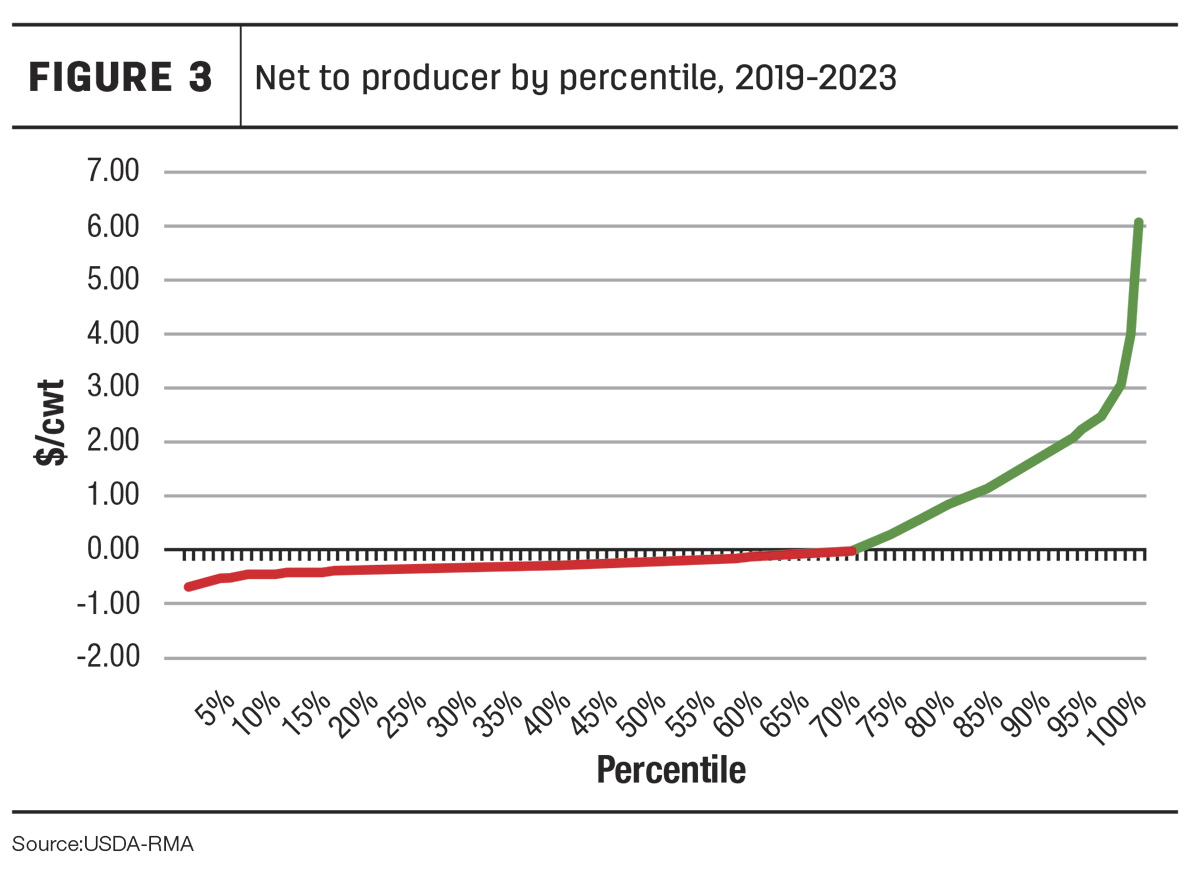Dairy Revenue Protection (Dairy-RP) has emerged as an effective risk management tool for dairy producers, offering protection against unexpected declines in quarterly milk revenue. Introduced in 2018, Dairy-RP became available for purchase starting in the first quarter of 2019. From 2019 to 2023, producers covered nearly 300 billion pounds of milk, accounting for roughly 27% of the U.S. milk supply. After five full years of Dairy-RP data to look back on, what insights have we gained?
1. Dairy-RP has resulted in a positive net benefit to producers
Over the past five years, every $1 producers spent on Dairy-RP coverage resulted in $1.78 returned to their wallets. The positive net benefit underscores the value of Dairy-RP in helping producers secure profits, particularly during depressed price periods. Figure 1 and Figure 2 illustrate the benefits of coverage from 2019 to 2023, portraying the range of outcomes under Dairy-RP compared to the actual Class III or Class IV price. Dairy-RP enabled producers to safeguard against downside price risk with limited opportunity losses. The producer premium (total premium minus premium subsidy) is the only cost associated with Dairy-RP, and since the program is designed to insure against declines in milk revenue, there is no limit to the upside if market conditions improve and prices rise.


As another example, Figure 3 displays the percentile distribution of net to producers (indemnity minus premium) over the five-year period. Although Dairy-RP losses were observed up to the 70th percentile, Dairy-RP had an unequal distribution of returns. In the largest cases, Dairy-RP paid out more than $6 per hundredweight (cwt) while costing producers less than $1 per cwt. The significant indemnity payments during poor-performing periods of the market outweighed the frequency of losses, resulting in an average net gain of 23 cents per cwt over the last five years.

2. Cheaper premiums do not mean greater profits
While cheaper premiums may seem appealing, they do not necessarily translate into greater profits. Over the last five years, most producers tended to secure coverage during the nearest quarter to expiration, primarily driven by the lower premiums associated with nearby coverage periods. However, the overall net benefit of Dairy-RP coverage based on the booking horizon indicated an advantage to securing coverage further in advance. Despite the higher premiums, coverage booked two to four quarters ahead yielded a significantly higher net benefit than coverage booked during the nearby quarter. Figure 4 highlights this, showing that coverage booked in the third quarter from expiration resulted in a much higher average net benefit, despite higher premiums. Opting for cheaper premiums may reduce the chance or magnitude of indemnity.

3. Do not let emotions get in the way
Timing the market sounds like a great idea, but accurately predicting the exact moment when dairy markets change direction is incredibly challenging. Instead, being proactive and consistent in obtaining Dairy-RP coverage can help remove emotion from the decision-making process.
To prove this point, Figure 5 depicts pounds effectively covered by Dairy-RP along with Class III and Class IV prices quarterly from 2019 to 2023, with the shading of the bars representing the magnitude of the average indemnity payment. The figure shows how emotions can influence coverage decisions, with drastic changes in coverage volumes based on market movements. For example, Class III and Class IV prices sharply declined during the COVID-19 pandemic in first-quarter and second-quarter 2020, leading to a substantial average indemnity payment of $1.79 per cwt in second-quarter 2020. This rapidly increased covered volume, which grew by nearly 42% from the second quarter to the third quarter. However, as Class III prices rebounded dramatically in the third and fourth quarters due to the Farmers to Families Food Box program, fewer payments caused producers to lose trust in the program, leading to reduced coverage volumes in the following quarters. Moreover, emotions continued to drive coverage decisions over the last two years. As Class III and Class IV prices reached new highs in early 2022, fewer indemnities were paid out, leading farmers to discontinue coverage for 2023. Coverage volume for the year hit its lowest mark since the program’s first year. But, as prices decreased from their 2022 highs, Dairy-RP coverage delivered considerable returns to dairy farmers throughout 2023, with indemnities averaging over $1 per cwt in every quarter during 2023.

Proactive producers booked coverage consistently in advance succeeded most during volatile price periods of the dairy market. While leaving emotion out of decision-making is easier said than done, it is essential to keep the overall goal of Dairy-RP in mind: protecting revenue from unexpected declines in the market.
The insights gleaned from the last five years of Dairy-RP data highlight the importance of strategic decision-making and a long-term perspective in managing risk. By leveraging the lessons learned from the past five years, producers can better position themselves to navigate the challenges of the dairy market and achieve greater financial stability.
To learn more facts and statistics on Dairy-RP over the past five years, check out HighGround’s report.
Note: This article is provided for information purposes only. Readers should consult their own professional advisers for specific advice tailored to their needs. Information contained in this article may be subject to change without notice.





